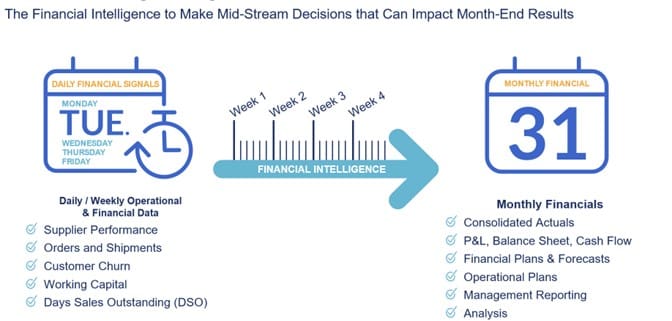While adding more planning processes to FP&A’s plate might seem overwhelming, strategic workforce planning is critical to Finance teams. Why? It aligns human capital strategies with financial goals and ensures optimal resource allocation, risk mitigation and adaptability – which collectively drive organizational success through a well-aligned and agile workforce. Now more than ever, then, Finance professionals looking to expand their skills need to understand strategic workforce planning and the role it plays in financial planning.
Strategic Workforce Planning Defined
Strategic workforce planning is a comprehensive approach to aligning an organization’s workforce and business strategy. Such planning involves anticipating and identifying the workforce capabilities required to achieve short- and long-term business goals.
But why is this planning important for an already busy Finance department in large organizations? Well, for Finance professionals across all industries, but especially in manufacturing, strategic workforce planning goes beyond traditional financial planning and forecasting. By integrating financial insights with human capital considerations, workforce planning ensures the workforce is cost-effective and strategically aligned with the company’s growth objectives.
Key market trends related to workforce and people planning in 2024 and beyond are important to understand. Especially important is how these trends are shaping the way organizations think about and manage their workforces.
Here are some of the most important trends:
- The aging workforce: The global population is aging, and this trend is having a significant impact on the workforce. In many countries, the number of working-age people age is declining as the number of retirees is increasing. This situation is putting a strain on social security systems and making it difficult for businesses to find qualified workers.
- The rise of remote work: The COVID-19 pandemic has accelerated the trend toward remote work. Many businesses have found that their employees can be just as productive working from home, leading to a shift in the way we think about work-life balance.
- The demand for skills-based hiring: Historically, businesses often hired based on qualifications and experience. The rise of technology and the increasing complexity of work, however, is making skill-based hiring more important. This trend is leading to a demand for more flexible and agile workforces.
- The need for diversity and inclusion: Businesses are increasingly recognizing the importance of diversity and inclusion in the workplace. A diverse workforce will not only bring new perspectives and ideas to the table, but also help to improve employee morale and productivity.
Why Strategic Workforce Planning Matters for Finance Professionals in Manufacturing
Strategic workforce planning provides a framework for Finance and other departments across the enterprise, including HR and Operations, to bring together their planning efforts into one cohesive, financialized plan that conceptualizes all the variables involving human capital. Bringing these variables together provides the following benefits, among others:
- Cost Optimization and Efficiency: Financial analysts will be familiar with the delicate balance between cost management and operational efficiency. Strategic workforce planning allows planners to optimize workforce costs by identifying areas for improvement, such as skill gaps, redundancies or over-reliance on external talent. By aligning workforce planning with financial goals, organizations can allocate resources more efficiently, ensuring the right people with the right skills are in the right roles.
- Risk Mitigation: In the volatile manufacturing sector, unforeseen disruptions can profoundly impact financial stability. Strategic workforce planning enables Finance professionals to assess and mitigate risks associated with workforce dynamics, such as talent shortages, turnover and skill gaps. By identifying potential risks early on, Finance teams can develop proactive strategies to address these challenges, safeguarding the organization’s financial health.
- Strategic Alignment: Finance must ensure that the organization is strategically positioned to adapt to industry changes. Strategic workforce planning helps align the workforce with the company’s strategic goals, fostering agility and responsiveness to market shifts. By having a workforce that can quickly adapt to new technologies and market demands, manufacturing companies can gain a competitive edge, directly impacting the bottom line.
- Talent Development and Retention: Investing in talent development is a crucial aspect of strategic workforce planning. By working closely with HR, Finance professionals can identify critical skills needed for the future and then implement training programs or hiring strategies accordingly. Retaining top talent is just as vital as talent development. By performing robust strategic workforce planning, companies can create an environment that fosters employee satisfaction and loyalty that ultimately decreases turnover and lessens the financial implications including recruitment costs and productivity loss.
The Role of Software in Strategic Workforce Planning
Bringing together many people across multiple departments with data from multiple sources can be challenging. After all, combining people, data and processes into one plan is already challenging enough. Being held back by outdated processes and systems adds another layer of complexity.
OneStream’s unified Corporate Performance Management (CPM) platform was built specifically to address these concerns in financial processes. By bridging the gap between data and people, OneStream’s best-in-class CPM platform gives users divisional autonomy while maintaining corporate standards and control – and does so with transparency and auditability into key financial data and decisions. Below are just a few of the technical enablers within OneStream that allow Finance teams to break free of burdensome technologies to unleash better strategic workforce planning:
- Financial Reporting and Analytics: OneStream unifies financial and operational insights to drive performance and deliver value. With OneStream, Finance teams not only can deliver the right information in the right format at the right time, but also can replace spreadsheets and standalone financial reporting software with a unified CPM platform. That platform can then be used to create customized dashboards and other useful self-service visualizations to allow Finance teams to quickly assess financial results on a regular basis.
- Real-Time Data: OneStream’s approach to financial signaling (Figure 1) provides real-time monitoring capabilities, allowing Finance professionals to continuously track key workforce metrics. This capability ensures organizations can break the month-end reporting cycle by transforming daily and weekly financial and operational signals from multiple data sources into actionable insights to drive performance.
- Scenario Modeling: OneStream’s CPM solution facilitates scenario planning, allowing Finance professionals to model various workforce scenarios and their financial implications. By using robust software that enables robust strategic workforce planning, Finance helps create contingency plans and adapt to different economic or industry conditions. OneStream allows users to create multiple what-if scenarios to model the impact of changes to key business drivers and internal scenarios to evaluate the financial outcomes of different workforce strategies.
- Predictive Analytics: Strategic workforce planning relies heavily on data analysis to enable informed decision-making. Advanced analytics allows for processing large datasets, providing Finance professionals with valuable insights into workforce trends, performance metrics and financial implications. With OneStream, Finance teams can enhance speed and accuracy by automating tasks; improve risk management to identify risks and capitalize on opportunities; and increase strategic decision-making with more data analysis done quickly with predictive analytic capabilities.

Ultimately, if the right people have access to the right data in a timely and repeatable manner, the quality of the outputs of strategic workforce planning becomes actionable and valuable to the organization. The experience of those involved in putting together the plan also improves.
Conclusion
Strategic workforce planning is vital to successful financial management in the manufacturing sector. Accordingly, Finance professionals are crucial in integrating financial strategies with human capital considerations to align workforce planning with overall business objectives. And by embracing software solutions like OneStream’s unified CPM platform for strategic workforce planning, Finance teams are empowered to leverage data-driven insights, streamline processes and make informed decisions that positively impact the bottom line.
As manufacturing continues to evolve, the collaboration between Finance and HR, facilitated by innovative software tools, will be vital in navigating the complexities of workforce dynamics and securing long-term financial success.
Learn More
To learn more about the power of planning for human capital and how OneStream’s intelligence finance platform can enable robust people planning, check out our solution brief People Planning for more.
This article first appeared on OneStream Software blog page by Whitney Gillespie



